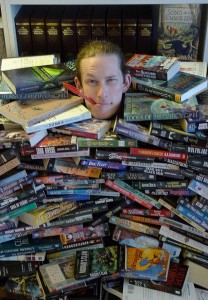A guest post by Joshua Essoe.
This is an intimidating subject, and one I think many authors have a lot of questions about. Should the characters indulge in a little horizontal refreshment? Do they or don’t they? Should I or shouldn’t I?
In loving someone else, we really do discover things about ourselves. The act of sex opens up all kinds of emotional territory for us, and it’s great to show characters discovering themselves through their physical loving of one another.
First, let’s decide if your story needs a love scene. Just like any other scene, ideally, it should do three things–advance the plot, show character progression, and turn you on . . . I mean entertain. If the sex can reveal character, or advance plot, or increase tension, you should consider including a little limb mingling in your story. Especially if the genre encourages it.
I read an awesome quote from Delilah S. Dawson who writes the Blud series:
“Remember in Mallrats, where they were doing the dating show, and the suitors were asked if their kisses were like a soft breeze, a firm handshake, or a jackhammer? Gil answered, “Definitely a jackhammer, I’m in there with some pressure and when I’m done, you’re not the same as before. You’re changed.” And we laughed, because he was a douche. But your sex scene should be like that: it should move the story forward and somehow affect the characters emotionally. Maybe the hero learns to open up, maybe the heroine decides she wants to be more aggressive in her real life, maybe they’re just having what they think is a last fling before a giant orc battle. But it has to mean something, or else it’s just porn.”
So here are some things to consider:
A) Is a character’s personal life necessary to the story?
B) Should the sex be explicit or implied?
C) What genre is it for?
Each genre is going to cook the meat and potatoes a different way, and have different expectations and limitations. Do your research and find out what is required, and what is prohibited. Keep in mind that just because a story has a sex scene in it, it doesn’t make it erotica any more than an action story becomes a romance because there is a romantic relationship in it.
Sex scenes and romances are all about the tension. They’re about building that moment that readers are waiting for. That moment where one thing turns to another. That first kiss after all those “innocent” touches, or all that longing. It’s that slow build to that first moment where the clothes finally come off, or the first time that one character finally admits that they love the other. The buildup is where it’s at. That’s what’s interesting and engaging. The reward of the actual kiss, or the I-love-you, or the sex is nice, but it means little without the buildup of characters and those characters’ desires. Wine and dine your readers before taking them home. Everybody enjoys some foreplay.
Terry Goodkind did a masterful job of creating romantic tension in his first few Sword of Truth books. We really wanted Kahlan and Richard to get together just as much as we were invested in the central conflict being resolved. When they finally kiss and when they finally get together, however briefly, it is immensely satisfying.
Another excellent lesson from that series is that the tension of their love affair decreased exponentially with each new book that kept them apart. With the repetitive pulling apart and coming back together, it became frustrating. You can’t be a one-trick pony, no matter how good that trick is; you have to show your readers new problems, give them new conflicts. There’s only so long readers will be willing to wait, and only so much they’ll be able to stand before getting frustrated or bored and putting your story down.
You have to keep up the cycle of tension, but it has to be fresh tension.
So, okay, the characters really do need to do the pickle tickle. It’s necessary to the story, okay? How do you handle it?
Unless the tone and mood calls for it, unless the characters and the story call for it, don’t be needlessly crass. There are plenty of ways to describe things, and use implied information to inform your readers of exactly what is going on.
In one sci-fi manuscript I read, the writer plunged me into gratuitous sex scene after gratuitous sex scene with no build-up or tonal foreshadowing, and seemingly without purpose besides the writer’s desire to write raunchy sex scenes. It was like having a picnic on a cloudless day that abruptly begins raining frogs on you. It didn’t make sense and was quite jarring.
Language is important. The specific words you use are important. Don’t write a book that has a little flirtation, and then jump into a chapter where one character is practically raping another. Don’t abstain from using any harsh language, and then use all the filthiest words you can come up with when you get to your sex scene. Your story needs consistency and everything must be set up so that you are appropriately managing your readers’ expectations.
Tone is important, but don’t be afraid to have a funny sex scene either. Coming-of-age sex scenes, for example, could be just as much about the humor in the awkwardness as it is about that life-changing event for the characters. You can still do funny, and tender, and sexy all in one scene if you want. Life is nuanced, and so should your sex scenes be.
In part two, we’ll take a deeper poke at how far to go, tropes, and character penetration. Until then, don’t write anything you’ll regret in the morning.
 About Joshua Essoe:
About Joshua Essoe:
Joshua Essoe is a full-time, freelance editor. He’s done work for best-seller David Farland, including the multi-award winning novel, Nightingale; Dean Lorey, lead writer of Arrested Development; best-seller, James Artimus Owen; and numerous Writers of the Future authors and winners, as well as many top-notch independents. He is currently the copy editor at Urban Fantasy Magazine.
Together with tie-in writer Jordan Ellinger, indie success-story, Michael J. Sullivan, and traditionally published author and NY Times best-seller, Debbie Viguie, he records the weekly writing podcast Hide and Create.
When not editing . . . ha ha, a joke. He was a 2014 finalist in the Writers of the Future contest, and lives with his wife, and three horrible cats near UCLA.

